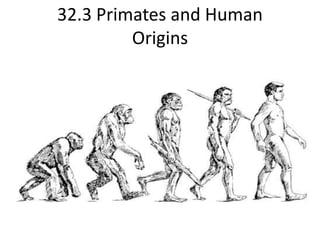
Biology 32.3
- 1. 32.3 Primates and Human Origins
- 2. Binocular Vision Ability to merge visual images from both eyes, which provides depth perception and a three-dimensional view of the world.
- 3. Prosimian Small, nocturnal primate that has large eyes for seeing in the dark.
- 4. Anthropoid Primate group made up of humans, apes, and most monkeys.
- 5. Prehensile Term used to refer to a long tail that can grasp branches.
- 6. Hominoid Anthropoid group that includes apes and humans.
- 7. Hominid Primate that walks upright, has opposable thumbs, and possesses a large brain; only living members are humans.
- 8. Bipedal Term used to refer to two-footed locomotion.
- 9. Opposable Thumb Thumbs that enables grasping objects and using tools.
- 10. Key Concept In general, primates have binocular vision, a well-developed cerebrum, relatively long fingers and toes, and arms that can rotate around their shoulder joints.
- 11. Key Concept Primates that evolved from two of the earliest branches look very little like typical monkeys and are called prosimians. Members of the familiar primate group that includes monkeys, apes, and humans are called anthropoids.
- 12. Key Concept It is now clear that hominid evolution did not proceed by the simple, straight-line transformation of one species into another. Rather, like the evolution of other mammalian groups, a series of complex adaptive radiations produced a large number of species whose relationships are difficult to determine.